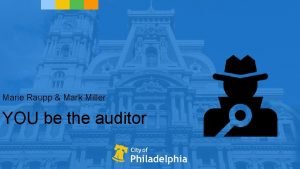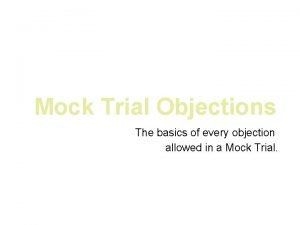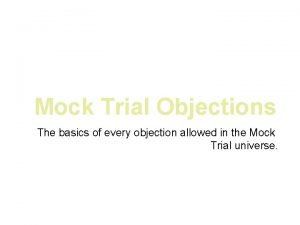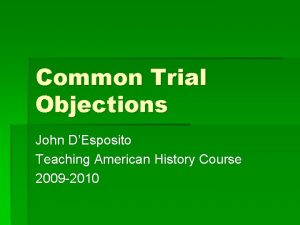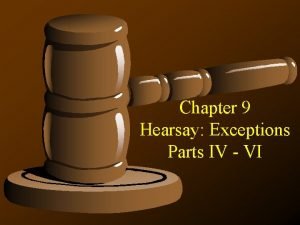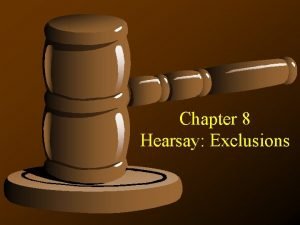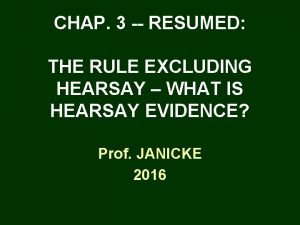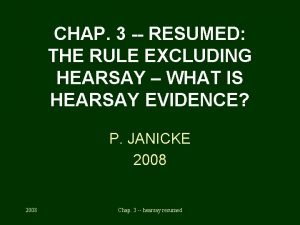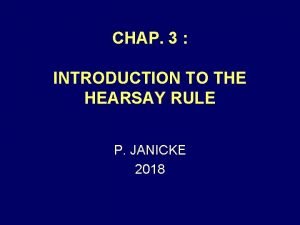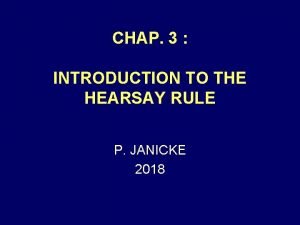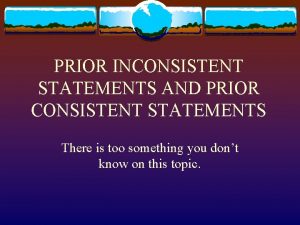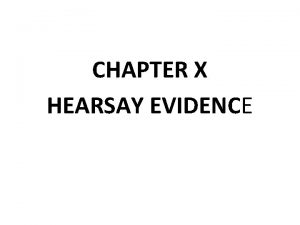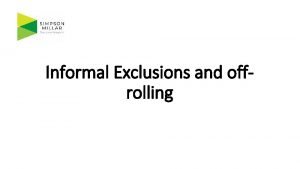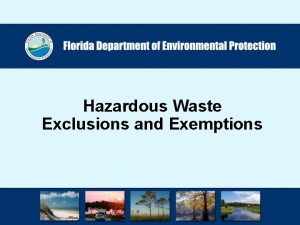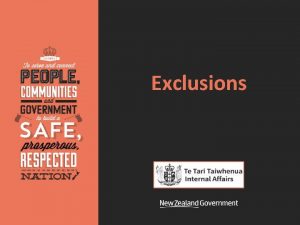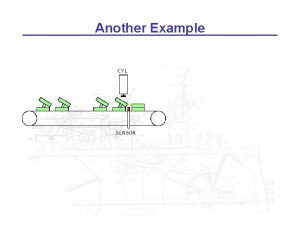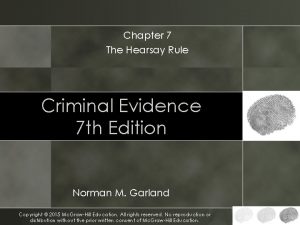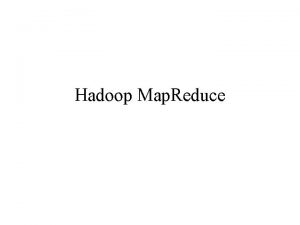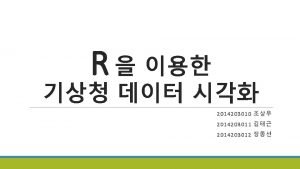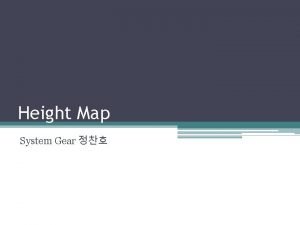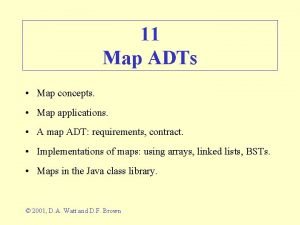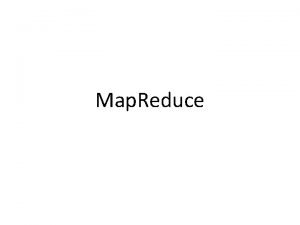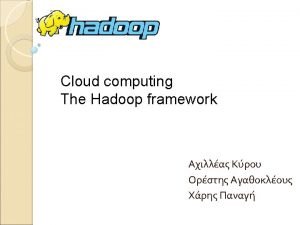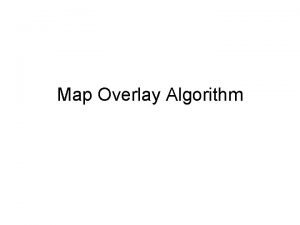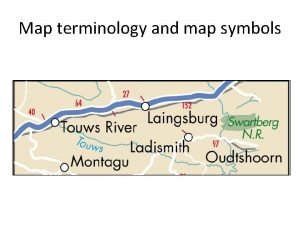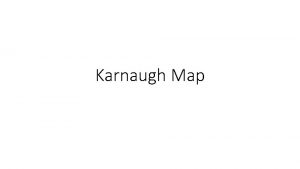Chapter 8 Hearsay Exclusions Another Map Is the







![FRE 801(d)(1)(A) A Declarant-Witness’s Prior Statement This Rule [801(d)(1)(A)] has the following requirements: o FRE 801(d)(1)(A) A Declarant-Witness’s Prior Statement This Rule [801(d)(1)(A)] has the following requirements: o](https://slidetodoc.com/presentation_image_h/1c47040108a159b4a4598fd0ae34750d/image-8.jpg)

![FRE 801(d)(1)(B) A Declarant-Witness’s Prior Statement This Rule [801(d)(1)(B)] has the following requirements: o FRE 801(d)(1)(B) A Declarant-Witness’s Prior Statement This Rule [801(d)(1)(B)] has the following requirements: o](https://slidetodoc.com/presentation_image_h/1c47040108a159b4a4598fd0ae34750d/image-10.jpg)

![FRE 801(d)(1)(C) A Declarant-Witness’s Prior Statement This Rule [801(d)(1)(C)] has the following requirements: o FRE 801(d)(1)(C) A Declarant-Witness’s Prior Statement This Rule [801(d)(1)(C)] has the following requirements: o](https://slidetodoc.com/presentation_image_h/1c47040108a159b4a4598fd0ae34750d/image-12.jpg)



![FRE 801(d)(2)(A) An Opposing Party’s Statement This Rule [801(d)(2)(A)] has the following requirements: o FRE 801(d)(2)(A) An Opposing Party’s Statement This Rule [801(d)(2)(A)] has the following requirements: o](https://slidetodoc.com/presentation_image_h/1c47040108a159b4a4598fd0ae34750d/image-16.jpg)

![FRE 801(d)(2)(B) An Opposing Party’s Statement This Rule [801(d)(2)(B)] has requirements: o The statement FRE 801(d)(2)(B) An Opposing Party’s Statement This Rule [801(d)(2)(B)] has requirements: o The statement](https://slidetodoc.com/presentation_image_h/1c47040108a159b4a4598fd0ae34750d/image-18.jpg)
![FRE 801(d)(2)(C) An Opposing Party’s Statement This Rule [801(d)(2)(C)] has requirements: o The statement FRE 801(d)(2)(C) An Opposing Party’s Statement This Rule [801(d)(2)(C)] has requirements: o The statement](https://slidetodoc.com/presentation_image_h/1c47040108a159b4a4598fd0ae34750d/image-19.jpg)
![FRE 801(d)(2)(D) An Opposing Party’s Statement This Rule [801(d)(2)(D)] has requirements: o The statement FRE 801(d)(2)(D) An Opposing Party’s Statement This Rule [801(d)(2)(D)] has requirements: o The statement](https://slidetodoc.com/presentation_image_h/1c47040108a159b4a4598fd0ae34750d/image-20.jpg)
![FRE 801(d)(2)(E) An Opposing Party’s Statement This Rule [801(d)(2)(E)] has requirements: o The statement FRE 801(d)(2)(E) An Opposing Party’s Statement This Rule [801(d)(2)(E)] has requirements: o The statement](https://slidetodoc.com/presentation_image_h/1c47040108a159b4a4598fd0ae34750d/image-21.jpg)


![FRE 801(d)(1)(A) A Declarant-Witness’s Prior Statement This Rule [801(d)(1)(A)] has the following requirements: o FRE 801(d)(1)(A) A Declarant-Witness’s Prior Statement This Rule [801(d)(1)(A)] has the following requirements: o](https://slidetodoc.com/presentation_image_h/1c47040108a159b4a4598fd0ae34750d/image-24.jpg)


![FRE 801(d)(1)(B) A Declarant-Witness’s Prior Statement This Rule [801(d)(1)(B)] has the following requirements: o FRE 801(d)(1)(B) A Declarant-Witness’s Prior Statement This Rule [801(d)(1)(B)] has the following requirements: o](https://slidetodoc.com/presentation_image_h/1c47040108a159b4a4598fd0ae34750d/image-27.jpg)
















- Slides: 43

Chapter 8 Hearsay: Exclusions

Another Map Is the statement in question one that meets the definition of hearsay under Rule 801(a) -(c)? No Hearsay Analysis Ends Yes Is the hearsay statement defined as “Not Hearsay” under Rule 801(d)(1) or 801(d)(2)? This question is the focus of Chapter 8. No Hearsay analysis continues as examined in Chapter 9 Yes Statement is not excluded by the Hearsay Rule

FRE 801(d). Statements Which Are Not Hearsay (d) Statements That Are Not Hearsay. A statement that meets the following conditions is not hearsay:

FRE 801(d). Statements Which Are Not Hearsay There are two types of statements which are considered “Not Hearsay” under Rule 801(d): (1) A Declarant-Witness’s Prior Statement and (2) An Opposing Party’s Statement

At this point, you have determined that the evidence in question: 1) IS a statement; 2) The statement in question meets the definition of hearsay;

Now you must determine whether the declarant is: 1) A witness; or 2) An opposing party.

801(d)(1) Declarant-Witness’s Prior Statement • 801(d)(1) has three different possibilities of statements which would be defined as “Not Hearsay” and, therefore, would not be excluded under the Hearsay rule of exclusion.
![FRE 801d1A A DeclarantWitnesss Prior Statement This Rule 801d1A has the following requirements o FRE 801(d)(1)(A) A Declarant-Witness’s Prior Statement This Rule [801(d)(1)(A)] has the following requirements: o](https://slidetodoc.com/presentation_image_h/1c47040108a159b4a4598fd0ae34750d/image-8.jpg)
FRE 801(d)(1)(A) A Declarant-Witness’s Prior Statement This Rule [801(d)(1)(A)] has the following requirements: o The declarant testifies [and] o The declarant is subject to cross-examination [and] o The statement (being offered) is inconsistent with the declarant’s testimony [and] o The statement (being offered) was given under penalty of perjury [and] o The statement was made at a trial, hearing, or other proceeding or in a deposition.

FRE 801(d)(1)(A) A Declarant-Witness’s Prior Statement If all of the requirements of Rule 801(d)(1)(A) have been met then the statement is “non-hearsay. ” That is, it is not excluded by the hearsay rule. If all of the requirements are NOT met, then the statement might meet the requirements of 801(d)(1)(B) or 801(d)(1)(C).
![FRE 801d1B A DeclarantWitnesss Prior Statement This Rule 801d1B has the following requirements o FRE 801(d)(1)(B) A Declarant-Witness’s Prior Statement This Rule [801(d)(1)(B)] has the following requirements: o](https://slidetodoc.com/presentation_image_h/1c47040108a159b4a4598fd0ae34750d/image-10.jpg)
FRE 801(d)(1)(B) A Declarant-Witness’s Prior Statement This Rule [801(d)(1)(B)] has the following requirements: o The declarant testifies [and] o The declarant is subject to cross-examination [and] o The statement (being offered) is consistent with the declarant’s testimony [and] {Either i or ii below} [i] The statement (being offered) is offered for the purpose of rebutting an express or implied charge of recent fabrication or improper influence or motive [ii] rehabilitate the declarant’s credibility as a witness when attached on another ground

FRE 801(d)(1)(B) A Declarant-Witness’s Prior Statement If all of the requirements of Rule 801(d)(1)(B) (i) or (ii) have been met then the statement is “non-hearsay. ” That is, it is not excluded by the hearsay rule. If all of the requirements are NOT met, then the statement might meet the requirements of 801(d)(1)(C).
![FRE 801d1C A DeclarantWitnesss Prior Statement This Rule 801d1C has the following requirements o FRE 801(d)(1)(C) A Declarant-Witness’s Prior Statement This Rule [801(d)(1)(C)] has the following requirements: o](https://slidetodoc.com/presentation_image_h/1c47040108a159b4a4598fd0ae34750d/image-12.jpg)
FRE 801(d)(1)(C) A Declarant-Witness’s Prior Statement This Rule [801(d)(1)(C)] has the following requirements: o The declarant testifies [and] o The declarant is subject to cross-examination [and] o The statement identifies a person as someone the declarant perceived earlier.

FRE 801(d)(1)(C) A Declarant-Witness’s Prior Statement If all of the requirements of Rule 801(d)(1)(C) have been met then the statement is “non-hearsay. ” That is, it is not excluded by the hearsay rule. If all of the requirements are NOT met, then the statement might meet the requirements of 801(d)(2).

Another - Another Map Is the statement in question one that meets the definition of hearsay under Rule 801(a) -(c)? No Hearsay Analysis Ends Yes Does the statement meet the Requirements of 801(d)(1)(A)? Yes No Does the statement meet the Requirements of 801(d)(1)(B)? Yes No Does the statement meet the Requirements of 801(d)(1)(C)? No Move on to 801(d)(2) analysis. Yes Statement is not excluded by the Hearsay Rule

![FRE 801d2A An Opposing Partys Statement This Rule 801d2A has the following requirements o FRE 801(d)(2)(A) An Opposing Party’s Statement This Rule [801(d)(2)(A)] has the following requirements: o](https://slidetodoc.com/presentation_image_h/1c47040108a159b4a4598fd0ae34750d/image-16.jpg)
FRE 801(d)(2)(A) An Opposing Party’s Statement This Rule [801(d)(2)(A)] has the following requirements: o The statement (being offered) is offered against an opposing party [and] o The statement (being offered) was made by the party in an individual capacity [or] o The statement (being offered) was made in a representative capacity.

Follow a logical path for your analysis: Similarly to what you did with 801(d)(1) you will examine the statements under each subpart of 801(d)(2). In other words, if 801(d)(2)(A) does not apply then look at B then C then D et cetera.
![FRE 801d2B An Opposing Partys Statement This Rule 801d2B has requirements o The statement FRE 801(d)(2)(B) An Opposing Party’s Statement This Rule [801(d)(2)(B)] has requirements: o The statement](https://slidetodoc.com/presentation_image_h/1c47040108a159b4a4598fd0ae34750d/image-18.jpg)
FRE 801(d)(2)(B) An Opposing Party’s Statement This Rule [801(d)(2)(B)] has requirements: o The statement (being offered) is offered against an opposing party [and] o The statement (being offered) is one that the party manifested that it adopted or believed to be true.
![FRE 801d2C An Opposing Partys Statement This Rule 801d2C has requirements o The statement FRE 801(d)(2)(C) An Opposing Party’s Statement This Rule [801(d)(2)(C)] has requirements: o The statement](https://slidetodoc.com/presentation_image_h/1c47040108a159b4a4598fd0ae34750d/image-19.jpg)
FRE 801(d)(2)(C) An Opposing Party’s Statement This Rule [801(d)(2)(C)] has requirements: o The statement (being offered) is offered against an opposing party [and] o The statement (being offered) was made by a person whom the party authorized to make the statement on the subject.
![FRE 801d2D An Opposing Partys Statement This Rule 801d2D has requirements o The statement FRE 801(d)(2)(D) An Opposing Party’s Statement This Rule [801(d)(2)(D)] has requirements: o The statement](https://slidetodoc.com/presentation_image_h/1c47040108a159b4a4598fd0ae34750d/image-20.jpg)
FRE 801(d)(2)(D) An Opposing Party’s Statement This Rule [801(d)(2)(D)] has requirements: o The statement (being offered) is offered against an opposing party [and] o The statement (being offered) was made by a party’s agent or employee on a matter within the scope of that relationship and while it existed.
![FRE 801d2E An Opposing Partys Statement This Rule 801d2E has requirements o The statement FRE 801(d)(2)(E) An Opposing Party’s Statement This Rule [801(d)(2)(E)] has requirements: o The statement](https://slidetodoc.com/presentation_image_h/1c47040108a159b4a4598fd0ae34750d/image-21.jpg)
FRE 801(d)(2)(E) An Opposing Party’s Statement This Rule [801(d)(2)(E)] has requirements: o The statement (being offered) is offered against an opposing party [and] o The statement (being offered) was made by the party’s coconspirator during and in furtherance of the conspiracy.

We will now examine many of these exclusions in greater detail.

A Declarant-Witness’s Prior Statement Prior Inconsistent Statement Rule 801(d)(1)(A)
![FRE 801d1A A DeclarantWitnesss Prior Statement This Rule 801d1A has the following requirements o FRE 801(d)(1)(A) A Declarant-Witness’s Prior Statement This Rule [801(d)(1)(A)] has the following requirements: o](https://slidetodoc.com/presentation_image_h/1c47040108a159b4a4598fd0ae34750d/image-24.jpg)
FRE 801(d)(1)(A) A Declarant-Witness’s Prior Statement This Rule [801(d)(1)(A)] has the following requirements: o The declarant testifies [and] o The declarant is subject to cross-examination [and] o The statement (being offered) is inconsistent with the declarant’s testimony [and] o The statement (being offered) was given under penalty of perjury [and] o The statement was made at a trial, hearing, or other proceeding or in a deposition.

United States v. Mornan 3 rd Circuit 413 F. 3 d 372 (2005) 326

A Declarant-Witness’s Prior Statement Prior Consistent Statement Rule 801(d)(1)(B)
![FRE 801d1B A DeclarantWitnesss Prior Statement This Rule 801d1B has the following requirements o FRE 801(d)(1)(B) A Declarant-Witness’s Prior Statement This Rule [801(d)(1)(B)] has the following requirements: o](https://slidetodoc.com/presentation_image_h/1c47040108a159b4a4598fd0ae34750d/image-27.jpg)
FRE 801(d)(1)(B) A Declarant-Witness’s Prior Statement This Rule [801(d)(1)(B)] has the following requirements: o The declarant testifies [and] o The declarant is subject to cross-examination [and] o The statement (being offered) is consistent with the declarant’s testimony [and] {Either i or ii below} [i] The statement (being offered) is offered for the purpose of rebutting an express or implied charge of recent fabrication or improper influence or motive [ii] rehabilitate the declarant’s credibility as a witness when attached on another ground

Tome v. United States Supreme Court of the United States 512 U. S. 150 (1995) 330

A Declarant-Witness’s Prior Statement of Identification of a Person Rule 801(d)(1)(C)

United States v. Lewis 2 nd Circuit 565 F. 2 d 1248 (1977) 336

An Opposing Party’s Statement A Party’s Own Statement Rule 801(d)(2)(A)

Jordan v. Binns 7 th Circuit 712 F. 3 d 1123 (2013) 340

An Opposing Party’s Statement Adopted Statements Rule 801(d)(2)(B)

United States v. Miller 1 st Circuit 478 F. 3 d 48 (2007) 344

An Opposing Party’s Statement Authorized Statements Rule 801(d)(2)(C)

Kirk v. Raymark Industries 3 rd Circuit 61 F. 3 d 147 (1995) 348

An Opposing Party’s Statements by a Party’s Agent Rule 801(d)(2)(D)

Mahlandt v. Wild Canid Survival & Research Center, Inc. 8 th Circuit 588 F. 2 d 626 (1978) 351

An Opposing Party’s Statements by Coconspirators Rule 801(d)(2)(E)

Preliminary Factual Determinations 1) Was there a conspiracy? 2) Was the declarant a member of the conspiracy? 3) Was the statement made while the conspiracy was in existence? 4) Was the statement made in furtherance of the conspiracy?

Bourjaily v. United States The United States Supreme Court 483 U. S. 171 (1987) 358

Review the Logic Maps of 801(d)(1) and 801(d)(2) 364 -365

End of Chapter 8
 Rochville university
Rochville university Harris burdick captain tory
Harris burdick captain tory Hearsay definition
Hearsay definition Objection hearsay
Objection hearsay Objection hearsay
Objection hearsay Court objections
Court objections Statement against interest hearsay
Statement against interest hearsay Heresay definition
Heresay definition Hearsay examples
Hearsay examples What is hearsay
What is hearsay Hearsay examples
Hearsay examples Hearsay examples
Hearsay examples Prior inconsistent statement
Prior inconsistent statement Hát kết hợp bộ gõ cơ thể
Hát kết hợp bộ gõ cơ thể Frameset trong html5
Frameset trong html5 Bổ thể
Bổ thể Tỉ lệ cơ thể trẻ em
Tỉ lệ cơ thể trẻ em Voi kéo gỗ như thế nào
Voi kéo gỗ như thế nào Tư thế worm breton là gì
Tư thế worm breton là gì Alleluia hat len nguoi oi
Alleluia hat len nguoi oi Kể tên các môn thể thao
Kể tên các môn thể thao Thế nào là hệ số cao nhất
Thế nào là hệ số cao nhất Các châu lục và đại dương trên thế giới
Các châu lục và đại dương trên thế giới Công thức tính độ biến thiên đông lượng
Công thức tính độ biến thiên đông lượng Trời xanh đây là của chúng ta thể thơ
Trời xanh đây là của chúng ta thể thơ Mật thư tọa độ 5x5
Mật thư tọa độ 5x5 Làm thế nào để 102-1=99
Làm thế nào để 102-1=99 độ dài liên kết
độ dài liên kết Các châu lục và đại dương trên thế giới
Các châu lục và đại dương trên thế giới Thể thơ truyền thống
Thể thơ truyền thống Quá trình desamine hóa có thể tạo ra
Quá trình desamine hóa có thể tạo ra Một số thể thơ truyền thống
Một số thể thơ truyền thống Bàn tay mà dây bẩn
Bàn tay mà dây bẩn Vẽ hình chiếu vuông góc của vật thể sau
Vẽ hình chiếu vuông góc của vật thể sau Nguyên nhân của sự mỏi cơ sinh 8
Nguyên nhân của sự mỏi cơ sinh 8 đặc điểm cơ thể của người tối cổ
đặc điểm cơ thể của người tối cổ Giọng cùng tên là
Giọng cùng tên là Vẽ hình chiếu đứng bằng cạnh của vật thể
Vẽ hình chiếu đứng bằng cạnh của vật thể Vẽ hình chiếu vuông góc của vật thể sau
Vẽ hình chiếu vuông góc của vật thể sau Thẻ vin
Thẻ vin đại từ thay thế
đại từ thay thế điện thế nghỉ
điện thế nghỉ Tư thế ngồi viết
Tư thế ngồi viết Diễn thế sinh thái là
Diễn thế sinh thái là
